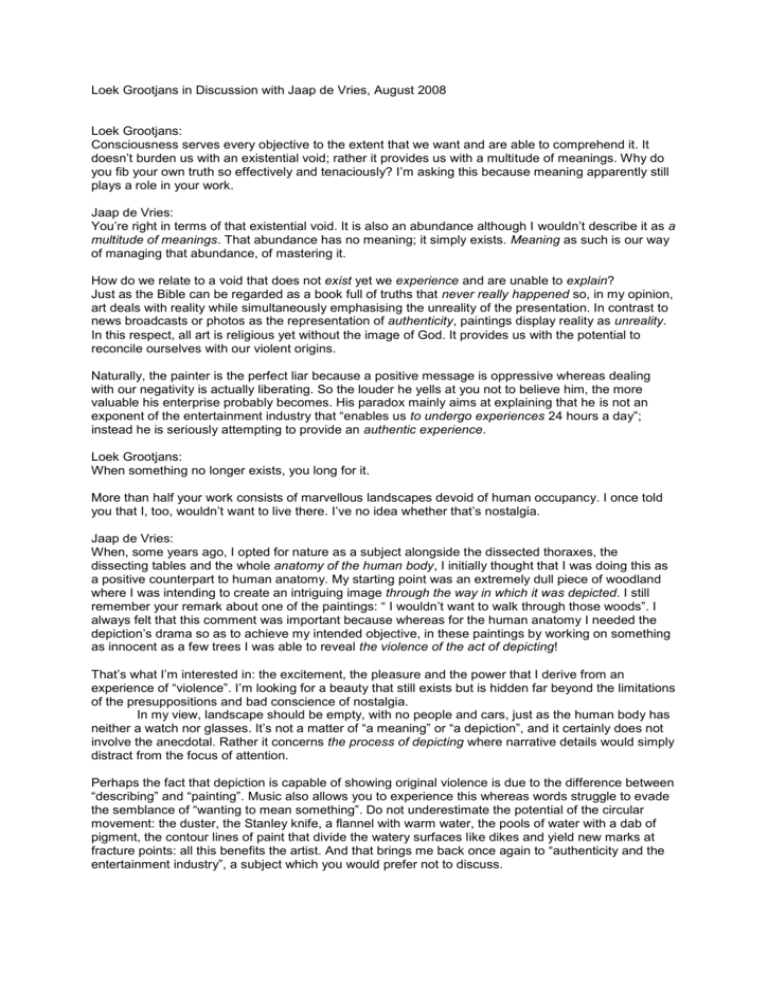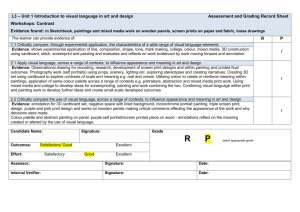Jaap de Vries
advertisement

Loek Grootjans in Discussion with Jaap de Vries, August 2008 Loek Grootjans: Consciousness serves every objective to the extent that we want and are able to comprehend it. It doesn’t burden us with an existential void; rather it provides us with a multitude of meanings. Why do you fib your own truth so effectively and tenaciously? I’m asking this because meaning apparently still plays a role in your work. Jaap de Vries: You’re right in terms of that existential void. It is also an abundance although I wouldn’t describe it as a multitude of meanings. That abundance has no meaning; it simply exists. Meaning as such is our way of managing that abundance, of mastering it. How do we relate to a void that does not exist yet we experience and are unable to explain? Just as the Bible can be regarded as a book full of truths that never really happened so, in my opinion, art deals with reality while simultaneously emphasising the unreality of the presentation. In contrast to news broadcasts or photos as the representation of authenticity, paintings display reality as unreality. In this respect, all art is religious yet without the image of God. It provides us with the potential to reconcile ourselves with our violent origins. Naturally, the painter is the perfect liar because a positive message is oppressive whereas dealing with our negativity is actually liberating. So the louder he yells at you not to believe him, the more valuable his enterprise probably becomes. His paradox mainly aims at explaining that he is not an exponent of the entertainment industry that “enables us to undergo experiences 24 hours a day”; instead he is seriously attempting to provide an authentic experience. Loek Grootjans: When something no longer exists, you long for it. More than half your work consists of marvellous landscapes devoid of human occupancy. I once told you that I, too, wouldn’t want to live there. I’ve no idea whether that’s nostalgia. Jaap de Vries: When, some years ago, I opted for nature as a subject alongside the dissected thoraxes, the dissecting tables and the whole anatomy of the human body, I initially thought that I was doing this as a positive counterpart to human anatomy. My starting point was an extremely dull piece of woodland where I was intending to create an intriguing image through the way in which it was depicted. I still remember your remark about one of the paintings: “ I wouldn’t want to walk through those woods”. I always felt that this comment was important because whereas for the human anatomy I needed the depiction’s drama so as to achieve my intended objective, in these paintings by working on something as innocent as a few trees I was able to reveal the violence of the act of depicting! That’s what I’m interested in: the excitement, the pleasure and the power that I derive from an experience of “violence”. I’m looking for a beauty that still exists but is hidden far beyond the limitations of the presuppositions and bad conscience of nostalgia. In my view, landscape should be empty, with no people and cars, just as the human body has neither a watch nor glasses. It’s not a matter of “a meaning” or “a depiction”, and it certainly does not involve the anecdotal. Rather it concerns the process of depicting where narrative details would simply distract from the focus of attention. Perhaps the fact that depiction is capable of showing original violence is due to the difference between “describing” and “painting”. Music also allows you to experience this whereas words struggle to evade the semblance of “wanting to mean something”. Do not underestimate the potential of the circular movement: the duster, the Stanley knife, a flannel with warm water, the pools of water with a dab of pigment, the contour lines of paint that divide the watery surfaces like dikes and yield new marks at fracture points: all this benefits the artist. And that brings me back once again to “authenticity and the entertainment industry”, a subject which you would prefer not to discuss. In the 18th century, nature was painted romantically or otherwise, and the landscape was experienced as “picturesque” because you recognised it from the paintings. The same applies to me. Just as at that time someone could say that he had enjoyed the Alps due to the paintings of (for instance) Caspar David Friedrich, I can also say that I have repeatedly enjoyed a trip to the butcher’s because of the paintings of Francis Bacon. However, I’m doing him a disservice here because I think that Bacon of all people was well aware that depiction is per se the violent factor. What freedom this creates! I am extremely dissatisfied by what I have done up till now. I’m only just beginning to really paint, but I am on the right track! Loek Grootjans: As based on Romanticism (Caspar David Friedrich), landscape is thought of as blissful, as “an environment” that we regard as an entity and could be a part of. There is a desire to be at one with this world. This world is nature. And nature is God. Descartes thought that God had our best interests at heart: He allows us to be at one with nature, at one with landscape. But nothing and no one has our interests at heart. We must look after ourselves with all the consequences that this entails. And that’s difficult to accept. Because it does indeed suggest that everything is possible. Jaap de Vries: In painting, everything is indeed possible. That’s its beauty. Loek Grootjans: That makes it so special. But at the same time painting’s absolute potential - possibly its all-embracing quality - also constitutes a hopeful inadequacy. Painting has impressed me for my entire conscious life for its ability to imbue with meaning what we are unable to express. Here, I am particularly thinking of the Modernists along with Yves Klein, Gerhard Richter, Luc Tuymans, Marcel Berlanger and yourself. The Modernists and Klein provided the possibility of being at one with the work and everything beyond it. Gerhard Richter established that a photo never depicts reality; instead it reveals the reality of a means of reproduction. This is in contrast to a painting where the paint constitutes the tangible material and, in visual terms, can also be a photograph. Therefore, in his opinion, painting is a more effective medium than photography. His view may also explain painting’s popularity and its constant revival. Your works - and here they relate to Tuymans’ - are in fact stills from a film, actual or imaginary. That’s what makes them so special. Indeed, everything is possible when based on a transformed rather than a real world. Then it is indeed feasible to paint a simple piece of woodland that makes your flesh creep. Jaap de Vries: I’ve wasted an incredible amount of time on the casting, finding the right locations, focusing, etcetera. At least that’s how I look back on it. You can’t force art, and I didn’t even know what I was doing. But that’s also how it should be. I’m not being cute when I say that I’ve just begun. I wasn’t looking for a script or a plot but for the image that could engorge itself on them yet simultaneously destroy all scripts and plots. All this is set against the tide of images and away from the comforting picture of the world as dictated by the glossy media industry. This calm and mirroring sea is as dead as a dodo and is, in my opinion, partly responsible for the fact that the whole world is as dead as a dodo and completely unreal. Those who argue that perversion and darkness are concealed in my work have never really looked at perversion and darkness. I feel like a salmon leaping upstream in the knowledge of the spawning ground close to the source… Loek Grootjans: In that sense you’re on course. You’ve found your river, and the first rapids are in sight or are already being taken. Jaap de Vries: You cannot imagine my longing.







